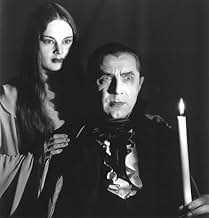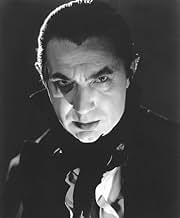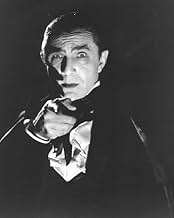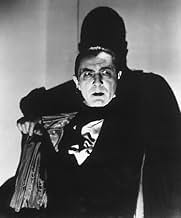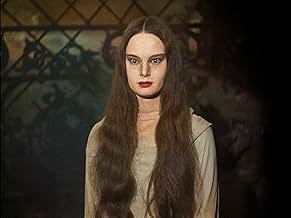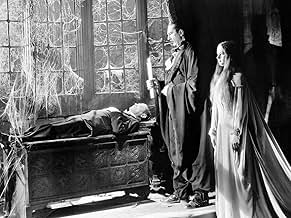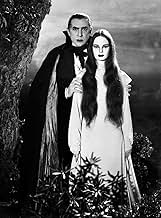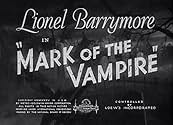AVALIAÇÃO DA IMDb
6,3/10
5,9 mil
SUA AVALIAÇÃO
Adicionar um enredo no seu idiomaWhen a nobleman is murdered, a professor of the occult blames vampires, but not all is what it seems.When a nobleman is murdered, a professor of the occult blames vampires, but not all is what it seems.When a nobleman is murdered, a professor of the occult blames vampires, but not all is what it seems.
- Direção
- Roteiristas
- Artistas
- Prêmios
- 1 indicação no total
Ivan F. Simpson
- Jan
- (as Ivan Simpson)
Carroll Borland
- Luna
- (as Carol Borland)
Eily Malyon
- Sick Woman
- (cenas deletadas)
Guy Bellis
- Ronnie - Englishman at Inn
- (não creditado)
James Bradbury Jr.
- Fourth Vampire
- (não creditado)
Avaliações em destaque
This is an ingenious, delicious film that offers a different take on the vampire tale. It's a remake of director Tod Brownings' 1927 silent "London After Midnight", one of the most sought after "lost" films of all time. It features a number of the trappings of the vampire sub genre, and establishes a respectfully sinister atmosphere.
When a man named Sir Karell (Holmes Herbert) is found murdered, an investigation is launched by intrepid Inspector Neumann (Lionel Atwill, who's in fine huffy form). When it's believed that the death was a murder perpetrated by a vampire, an occult expert (a hilarious, delightful Lionel Barrymore) is called in to provide all the advice they could need.
And for a while, this plays out the way we would expect a vampire movie TO play out. Our blood suckers are played by Bela Lugosi, once again cast in a perfect sort of role for him, and Carroll Borland, whose striking, long haired Luna can easily be seen as a forerunner to characters like Vampira and Morticia Addams. The cast is rounded out with people such as Elizabeth Allan as the distraught Irena, Henry Wadsworth as her suitor, Jean Hersholt as her uncle (the worried Baron), Donald Meek as Dr. Doskill, Ivan F. Simpson as Jan the butler, and comedy relief provider Leila Bennett as Maria the maid.
One can't help but notice just how short this movie is - it runs barely over an hour - and in fact approximately 20 minutes of footage was cut after the preview. Unfortunately, because Brownings' previous film "Freaks" had flopped upon its release, he wasn't able to object to these studio decisions. Still, even in the movies' current incarnation, it works pretty well, with decent special effects and typically solid work by cinematographer James Wong Howe. But the reason why this should be so entertaining is the unexpected ending, which does a fine job of pulling the rug out from under us and turning into a different type of film altogether. Even the actors weren't informed of the big twist ending until it was time to shoot it, which does nothing but add to the effectiveness of their performances.
Overall, "Mark of the Vampire" is great fun and a worthy viewing for any fan of old school black & white genre entertainment.
Eight out of 10.
When a man named Sir Karell (Holmes Herbert) is found murdered, an investigation is launched by intrepid Inspector Neumann (Lionel Atwill, who's in fine huffy form). When it's believed that the death was a murder perpetrated by a vampire, an occult expert (a hilarious, delightful Lionel Barrymore) is called in to provide all the advice they could need.
And for a while, this plays out the way we would expect a vampire movie TO play out. Our blood suckers are played by Bela Lugosi, once again cast in a perfect sort of role for him, and Carroll Borland, whose striking, long haired Luna can easily be seen as a forerunner to characters like Vampira and Morticia Addams. The cast is rounded out with people such as Elizabeth Allan as the distraught Irena, Henry Wadsworth as her suitor, Jean Hersholt as her uncle (the worried Baron), Donald Meek as Dr. Doskill, Ivan F. Simpson as Jan the butler, and comedy relief provider Leila Bennett as Maria the maid.
One can't help but notice just how short this movie is - it runs barely over an hour - and in fact approximately 20 minutes of footage was cut after the preview. Unfortunately, because Brownings' previous film "Freaks" had flopped upon its release, he wasn't able to object to these studio decisions. Still, even in the movies' current incarnation, it works pretty well, with decent special effects and typically solid work by cinematographer James Wong Howe. But the reason why this should be so entertaining is the unexpected ending, which does a fine job of pulling the rug out from under us and turning into a different type of film altogether. Even the actors weren't informed of the big twist ending until it was time to shoot it, which does nothing but add to the effectiveness of their performances.
Overall, "Mark of the Vampire" is great fun and a worthy viewing for any fan of old school black & white genre entertainment.
Eight out of 10.
In a small village of Prague, dignitary Sir Karell Borotyn is found murdered and the police put it down to "unknown circumstances". The whole village knows the cause though and the consensus of opinion is that he was killed by the legendary vampire Count Mora. This belief is dismissed by the authorities but seems to be backed up when Mora appears to Borotyn's daughter Irena. Enter Professor Zelen, who plans to save Irena and bring an end to the rule of terror that Mora has brought to the village.
I have been watching several horrors from the first half of the last century recently mainly because I am tired of the "shock 'em with gore" school of thought that seems to have replaced atmosphere and creepy direction that should always make up a part of a horror film. With this film the story is actually quite interesting, albeit based on the usual "vampire hunter" storyline but it still works and has a certain amount of mystery to it. This is supported by a good sense of atmosphere and period not just all dark shadows and so on but a feeling that this is a real place and that the evil is only a few steps away at any time; hard to describe but it looks good. Of course it is dated and modern horror fans will scoff at it, but it does have some genuinely unsettling moments and the slow movement of Mora and the zombie-ish Luna is effectively used once or twice it was only a shame that they had surprisingly little actual time on screen.
The cast are impressive on paper and they do a good job on screen. Lugosi may just be doing his usual stuff in a supporting role but both he and the Count are probably the main draw to this film and he provides his usual ham with relish. Likewise the rest of the cast overact a bit but it suits the film and works pretty well since this film doesn't seem to be taking itself too seriously. Barrymore is good and is well supported by Allan, Atwill and Borland. They all play it up a bit and it works without taking away from the creepy atmosphere.
Overall it is hardly the most frightening thing you'll ever see, nor does it even come comes but it is still enjoyable and a little creepy if you meet it on its terms rather than with a modern eye. It is creaky and you might get a laugh out of it but viewed as a film it has enough going for it to stand up with some of the more "classic" horrors of the period.
I have been watching several horrors from the first half of the last century recently mainly because I am tired of the "shock 'em with gore" school of thought that seems to have replaced atmosphere and creepy direction that should always make up a part of a horror film. With this film the story is actually quite interesting, albeit based on the usual "vampire hunter" storyline but it still works and has a certain amount of mystery to it. This is supported by a good sense of atmosphere and period not just all dark shadows and so on but a feeling that this is a real place and that the evil is only a few steps away at any time; hard to describe but it looks good. Of course it is dated and modern horror fans will scoff at it, but it does have some genuinely unsettling moments and the slow movement of Mora and the zombie-ish Luna is effectively used once or twice it was only a shame that they had surprisingly little actual time on screen.
The cast are impressive on paper and they do a good job on screen. Lugosi may just be doing his usual stuff in a supporting role but both he and the Count are probably the main draw to this film and he provides his usual ham with relish. Likewise the rest of the cast overact a bit but it suits the film and works pretty well since this film doesn't seem to be taking itself too seriously. Barrymore is good and is well supported by Allan, Atwill and Borland. They all play it up a bit and it works without taking away from the creepy atmosphere.
Overall it is hardly the most frightening thing you'll ever see, nor does it even come comes but it is still enjoyable and a little creepy if you meet it on its terms rather than with a modern eye. It is creaky and you might get a laugh out of it but viewed as a film it has enough going for it to stand up with some of the more "classic" horrors of the period.
Sir Karrel Borotyn is found dead with two punctures on his neck and drained of all his blood. A professor (Lionel Barrymore) and a police inspector (Lionel Atwill) investigate and all evidence points to vampires. Now it looks like Sir Karrel's daughter (Elizabeth Allan) is being targeted by the blood suckers.
Director Tod Browning's remake of his now-lost film "London After Midnight." In the original, Lon Chaney played multiple parts. Here his roles are divided among Lionel Barrymore, Bela Lugosi, and Lionel Atwill. Lots of horror fans dislike this one because they feel the ending is a cheat. I thought the ending was great, though it might not hold up on closer scrutiny of certain previous scenes. The entire movie plays out more like a murder mystery with horror overtones rather than a straight horror film, so I didn't feel cheated at all. It's beautifully shot by James Wong Howe. The cast is great. Lugosi barely says anything but is a menacing presence in a Draculaesque role. Carol Borland is sufficiently creepy as his "daughter." Definitely a keeper.
Director Tod Browning's remake of his now-lost film "London After Midnight." In the original, Lon Chaney played multiple parts. Here his roles are divided among Lionel Barrymore, Bela Lugosi, and Lionel Atwill. Lots of horror fans dislike this one because they feel the ending is a cheat. I thought the ending was great, though it might not hold up on closer scrutiny of certain previous scenes. The entire movie plays out more like a murder mystery with horror overtones rather than a straight horror film, so I didn't feel cheated at all. It's beautifully shot by James Wong Howe. The cast is great. Lugosi barely says anything but is a menacing presence in a Draculaesque role. Carol Borland is sufficiently creepy as his "daughter." Definitely a keeper.
After the commercial failure of his controversial masterpiece "Freaks" in 1932, director Tod Browning found himself in serious problems to find new projects. Browning was a man of proved talent, being the director of some of the best silent films starring Lon Chaney as well as the mind behind the 1931 horror masterpiece "Dracula". However, "Freaks" proved to be too ahead of its time and sadly suffered the prejudices of audiences clearly unprepared for the tragic story of a midget in love with a full grown woman. In this state of disgrace, the studio rejected his projects and instead gave him the job of directing "Fast Workers", a melodrama with former silent superstar John Gilbert. Fortunately, luck was still on his side as in 1935 he was allowed to direct a remake of his successful silent "London After Midnight", a movie that would reunite Browning with Dracula himself: Bela Lugosi.
"Mark of the Vampire" is the story of the tragedy surrounding the wealthy Borotyn family. The patriarch, Sir Karell Borotyn (Holmes Herbert) has been murdered under mysterious circumstances, and soon everyone in town suspects it was the work of Count Mora (Bela Lugosi) and his daughter Luna (Carroll Borland), as these two deceased nobles are rumored to awake by night as vampires and wreak havoc in the small superstitious village. Inspector Neumann (Lionel Atwill) doesn't believe in this, as he suspects there is a more mundane motif for the murder of the rich old man, however, when Sir Karell's only daughter Irena (Elizabeth Allan) becomes the vampires' new target, Insp. Neumann will have to join forces with a strange scientist specialized in the occult, Prof. Zelin (Lionel Barrymore) to solve the mystery before someone else gets killed.
As written above, "Mark of the Vampire" is essentially a remake of the now lost classic "London After Midnight", although this time Browning enhances the horror elements of the story by focusing on the couple of vampires and their actions instead of the mystery of the plot. The story is pretty convoluted and very clever for its time, with a nice use of black humor (some even see it as a satire of horror films of it's time) and very surprising plot twists to keep the mystery a secret until the end. Sadly (and like always happened to Browning), the film suffered approximately 20 minutes of cuts by the studio, who disliked Browning's idea of incest as background for Count Mora among other things. Unable to fight the studio (as they were still mad at him for "Freaks"), Browning had to let them cut the film, leading to the creation of many plot holes in the already convoluted story, ultimately destroying most of its effect by enhancing its flaws.
As in most Browning's films, the power of the movie is in the haunting visuals conveyed by this master of silent films, images so powerful that in a way make up for the messed up and disjointed storyline. In fact (and like "Dracula"), most of the best scenes in "Mark of the Vampire" come when nobody talks and only the images are what carry the story. Taking his expressionist influences to the max, Browning makes the figure of the vampire to embody the ultimate vision of irresistible evil, as their unnatural shining in complete darkness makes them diabolically attractive. Browning always struggled with the use of sound, and this problem shows again in "Mark of the Vampire", although the high quality of his cast manage to improve Browning's direction in this "talkie".
Lionel Barrymore is very good as the eccentric Prof. Zelin, and while he receives some bash for giving an over-the-top performance, I think his acting is right on the money, as he is not a serious Van Helsing, his character seems to be wicked, almost as wicked as the monsters he fights, so his hammy touch is, in my opinion, very appropriate. Lionel Atwill shines as Insp. Neumann, bringing a sense of dignity to the film as the stoic hero who is forced to work with what he considers as superstitious fools in order to fulfill his mission. Borland and Luogsi are simply wonderful as the almost silent vampires, relaying mostly on gestures to convey their emotions. Jean Hersholt, Donald Meek and Ivan Simpson have nice turns in supporting roles, with Meek and Simpson delivering some nice comedy that seems to parody stereotypes of horror films of its time.
Sadly, the film (or what was left of it) suffers from many flaws that effectively make the brilliant parts of it look bad, leaving the final product as simply a slightly better than average 30s movie. Not only the cuts done by the studio ruined the storyline, as being honest, Browning's talent wasn't as fond of talkies as it was of silents. Browning was a genius of black comedy, but this skill couldn't translate well to sound movies and often his attempts of comedy look too over-the-top for the overall mood of the movie. To make things worse, the performances of Elizabeth Allan and Henry Wadsworth (the main romantic couple of the movie) are atrociously poor, paling in comparison to the work of the rest of the cast.
"Mark of the Vampire" is a very good film of Browning's short post-"Freaks" career, as despite being plagued by many problems, it still works as a nice tale of mystery and horror. It is definitely not the typical vampire movie, and a number of factors make me to be willing to believe that Browning intended this to be a satire than a proper horror (for example the fact that vampires are silent and humans are very talkative for example). While certainly not a masterpiece, it is a fine film to watch despite its troubled upbringing. 7/10
"Mark of the Vampire" is the story of the tragedy surrounding the wealthy Borotyn family. The patriarch, Sir Karell Borotyn (Holmes Herbert) has been murdered under mysterious circumstances, and soon everyone in town suspects it was the work of Count Mora (Bela Lugosi) and his daughter Luna (Carroll Borland), as these two deceased nobles are rumored to awake by night as vampires and wreak havoc in the small superstitious village. Inspector Neumann (Lionel Atwill) doesn't believe in this, as he suspects there is a more mundane motif for the murder of the rich old man, however, when Sir Karell's only daughter Irena (Elizabeth Allan) becomes the vampires' new target, Insp. Neumann will have to join forces with a strange scientist specialized in the occult, Prof. Zelin (Lionel Barrymore) to solve the mystery before someone else gets killed.
As written above, "Mark of the Vampire" is essentially a remake of the now lost classic "London After Midnight", although this time Browning enhances the horror elements of the story by focusing on the couple of vampires and their actions instead of the mystery of the plot. The story is pretty convoluted and very clever for its time, with a nice use of black humor (some even see it as a satire of horror films of it's time) and very surprising plot twists to keep the mystery a secret until the end. Sadly (and like always happened to Browning), the film suffered approximately 20 minutes of cuts by the studio, who disliked Browning's idea of incest as background for Count Mora among other things. Unable to fight the studio (as they were still mad at him for "Freaks"), Browning had to let them cut the film, leading to the creation of many plot holes in the already convoluted story, ultimately destroying most of its effect by enhancing its flaws.
As in most Browning's films, the power of the movie is in the haunting visuals conveyed by this master of silent films, images so powerful that in a way make up for the messed up and disjointed storyline. In fact (and like "Dracula"), most of the best scenes in "Mark of the Vampire" come when nobody talks and only the images are what carry the story. Taking his expressionist influences to the max, Browning makes the figure of the vampire to embody the ultimate vision of irresistible evil, as their unnatural shining in complete darkness makes them diabolically attractive. Browning always struggled with the use of sound, and this problem shows again in "Mark of the Vampire", although the high quality of his cast manage to improve Browning's direction in this "talkie".
Lionel Barrymore is very good as the eccentric Prof. Zelin, and while he receives some bash for giving an over-the-top performance, I think his acting is right on the money, as he is not a serious Van Helsing, his character seems to be wicked, almost as wicked as the monsters he fights, so his hammy touch is, in my opinion, very appropriate. Lionel Atwill shines as Insp. Neumann, bringing a sense of dignity to the film as the stoic hero who is forced to work with what he considers as superstitious fools in order to fulfill his mission. Borland and Luogsi are simply wonderful as the almost silent vampires, relaying mostly on gestures to convey their emotions. Jean Hersholt, Donald Meek and Ivan Simpson have nice turns in supporting roles, with Meek and Simpson delivering some nice comedy that seems to parody stereotypes of horror films of its time.
Sadly, the film (or what was left of it) suffers from many flaws that effectively make the brilliant parts of it look bad, leaving the final product as simply a slightly better than average 30s movie. Not only the cuts done by the studio ruined the storyline, as being honest, Browning's talent wasn't as fond of talkies as it was of silents. Browning was a genius of black comedy, but this skill couldn't translate well to sound movies and often his attempts of comedy look too over-the-top for the overall mood of the movie. To make things worse, the performances of Elizabeth Allan and Henry Wadsworth (the main romantic couple of the movie) are atrociously poor, paling in comparison to the work of the rest of the cast.
"Mark of the Vampire" is a very good film of Browning's short post-"Freaks" career, as despite being plagued by many problems, it still works as a nice tale of mystery and horror. It is definitely not the typical vampire movie, and a number of factors make me to be willing to believe that Browning intended this to be a satire than a proper horror (for example the fact that vampires are silent and humans are very talkative for example). While certainly not a masterpiece, it is a fine film to watch despite its troubled upbringing. 7/10
Count Mora has a scar on his temple. It's a gunshot wound acquired when after having incest with his daughter he committed suicide. That was meant to explain to the audiences how he and his daughter became vampires. But censors demanded the deletion of references to both the incest and the suicide.
Você sabia?
- CuriosidadesThroughout the film, Count Mora (Bela Lugosi) has an unexplained bullet wound on his temple. In the original script Mora was supposed to have had an incestuous relationship with his daughter Luna and to have committed suicide. After filming began, however, MGM deleted references to the crime (and any remaining references may have been deleted when 20 minutes of footage was removed after the film's preview). Because director Tod Browning's previous film, Monstros (1932), had been a box-office disaster, he was unable to object to any changes made by the studio.
- Erros de gravaçãoThe character of Jan (pronounced as it would be in Prague as "yan") is referred to by the English pronunciation inexplicably by one character a few times before returning to pronouncing it correctly.
- Citações
[Last Lines]
Count Mora: This vampire business, it has given me a great idea for a new act. Luna, in this new act I will be the vampire. Did you watch me? I gave all of me. I was greater than any real vampire.
Luna Mora: Sure, sure, but get off your makeup.
Fourth Vampire: Yes, and help me with some of this packing.
- Versões alternativasThere is an Italian DVD edition of this movie, distributed by DNA Srl. The movie was re-edited with the contribution of the film history scholar Riccardo Cusin. This version is also available in streaming on some platforms.
- ConexõesEdited into Mondo Lugosi - A Vampire's Scrapbook (1987)
Principais escolhas
Faça login para avaliar e ver a lista de recomendações personalizadas
Detalhes
- Data de lançamento
- País de origem
- Idiomas
- Também conhecido como
- La marca del vampiro
- Locações de filme
- Empresa de produção
- Consulte mais créditos da empresa na IMDbPro
Bilheteria
- Orçamento
- US$ 305.177 (estimativa)
- Tempo de duração1 hora
- Cor
- Proporção
- 1.37 : 1
Contribua para esta página
Sugerir uma alteração ou adicionar conteúdo ausente



